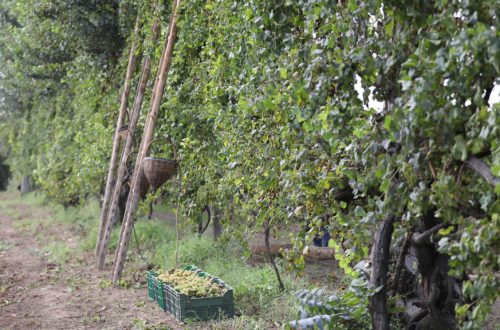Cortese
Cortese (cor TAE sae) is one of the primary white grape varieties of the Piemonte region and is the only varietal used in Gavi di Gavi wines. It is also grown in Lombardy in the Oltrepò Pavese region and in the Veneto.
Origins/history of Cortese Grape
The first documented reference to Cortese was in 1614 as part of the wine cellar contents at the castle of Cassle Monferrato. Additional documentation refers to Cortese being planted alongside “Fermentino” and “Nebioli Dolci”, suggesting that the varietal has been a fundamental grape in Piemonte for centuries. Research has not determined parentage for the Cortese grape.
In the Vineyard
The climate is moderate in temperature and continental with rainfall limited to the winter months and relatively warm summers. Consistent winds provide good air circulation and reduce the risk of fungal diseases. Most vineyards are positioned on slopes of variable grade and range in sltitude from about 150 meters to upwards of 450 meters. Cool years can cause issues with adequate ripening of Cortese grapes and must adjustments are common in those vintages. The addition of concentrated grape must is allowed to balance the high acidity but the Rectified Concentrated Grape Must (RCGM) must use only Cortese grapes grown within the appellation.
Ampelography
Cortese is a very productive and vigorous grape varietal that must be managed in the vineyard to achieve balance in the finished wines. Acidity is key to Cortese wines and efforts to assure balance with fully ripened grapes is important for body and fruit concentration. Better winemakers find this balance and produce the best examples of Gavi with good body and balance. The best examples express flavors of lime and greengages and many of the wines undergo partial or full malolactic conversion to tame the acidity and achieve a slightly creamy mouthfeel.
Wine Regions in which it is cultivated
Gavi di Gavi is the most famous of the white wine DOCG regions in Piemonte. Located in southeastern Piemonte near the Ligurian Alps where locals and tourists connect from the Ligurian coastal city of Geneva (Genoa) to the Piemonte region. The DOCG area surrounds the city of Gavi and is found in the corner of Alto Monferrato, near Alessandria. There is an interesting transition of terroir from the typical Piemonte landscape to a blend of alternating hills and valleys with the Ligurian Alps proving a beautiful backdrop. The soils are complex and diverse with the highest quality wines produced on chalky soils. These wines, along with similar wines of Gavi di Tessorola achieve a higher degree of finesse and flavor concentration with more aromatic intensity.
DOC approval was given in 1974 and elevated to DOCG status in 1998. Eleven subregions or communes cover approximately 1400 hectares dedicated to Cortese and Gavi wine.
It is also grown in Lombardy in the Oltrepò Pavese region and in the Veneto
Wines in which it is used
Cortese is used in multiple IGP, DOC and DOCG wines but is primarily known for the Gavi di Gavi and Gavi di Tessorola wines. Cortese is also commonly used in Custoza blends in the Bianco di Custoza DOC of Veneto, often blended with Friulano, Garganega and Trebbiano. The Custoza whites are based on a minimum of 70% Cortese (known as Bianca Fernanda). Still, sparkling and passito wines are all produced in the Bianco di Custoza DOC.
In the Gavi di Gavi DOCG, 100% Cortese based White, Riserva, Spumante and Riserva Spumante Metodo Classico wines are produced. All DOCG wines of Gavi di Gavi are 100% cortese, similar to the approach taken with most red and white wines of the Piemonte region.
Tasting notes
Cortese has a subtle and restrained nature to it. The best examples of Cortese wines are moderately aromatic and characterized with refreshing and tart acidity, old-world minerality, lemon and tree fruit aromas and flavors. Gavi is a typical, back-palate Italian white wine, displaying refreshing and crisp acidity, citrus notes of lemon, yellow apple and delicate floral aromas. The wines are typically dry and crisp and the use of oak is minimized or avoided all together. Oak influences can overwhelm the delicate flavors and aromas of Gavi wines. Gavi wines pair well with antipasti, fish and chicken meals.
Noteworthy producers
We are working on this Cortese grape description. Please come back soon.
Send us an e-mail if you are looking for more info at
cheers@drinkitalian.com
Two of the best books about Italian grapes, where some of this information come from, are:
– Native Grapes of Italy, by Ian d’Agata
– Italian Wine Unplugged, by Steve Kim
Additionally, you can discover the other grapes from Piedmont.


